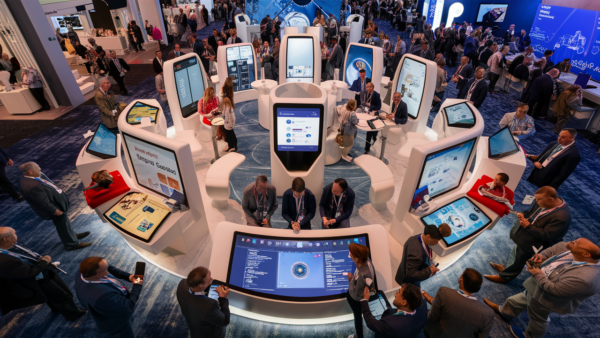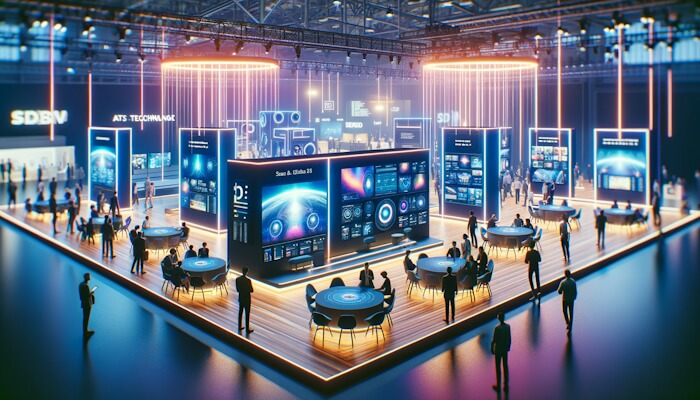As the heartbeat of any conference or event, audio-visual tech plays a crucial role in making sure presentations run smoothly and captivate audiences.
Managing these AV setups at conferences with many speakers and attendees is no easy task. However, there are plenty of technologies and techniques you can use to turn your exhibit from unnoticeable to unforgettable.
In this article, we’ll share our favorite strategies and tips for AV experts and companies to use exhibit AV with finesse and effectiveness.
1. Create an Experience Using Interactive Displays
Interactive displays and touchscreens are essentially giant tablets that make your exhibit stand out. Instead of just looking, visitors can actually experience them.
They boost visitor engagement using dynamic ways to interact with digital content through gestures, touch, or other input methods. That sounds much better than listening to a boring, static sales speech, right?
This tech gives AV techs a playground of possibilities at their fingertips where they can create tailored interfaces to set up interactive games, virtual tours, or gesture-controlled presentations.
It leverages tech like capacitive touchscreens that use changes in screen capacitance to detect touch. It’s a bit like a digital canvas where every swipe and tap creates a seamless experience.
Then there are infrared sensors that allow users to interact with the display without physically touching it. These sensors detect hand movements or gestures within their range so the experience is touchless yet intuitive.
Finally, the gesture recognition algorithms can interpret natural movements captured by sensors like cameras or depth sensors so users can control digital content with simple gestures like a hand swipe.
If you want to use interactive displays in your exhibit or conference, keep these best practices in mind:
- Simplify Navigation: Design interfaces with clear and intuitive navigation paths.
- Use Visual Feedback: Use visual cues such as animations or color changes to provide immediate feedback to user input.
- Optimize Touch Sensitivity: Calibrate touchscreens to minimize errors and frustration.
Don’t Forget Accessibility: Design interfaces with accessibility in mind, including features such as adjustable font sizes and audio descriptions for the visually impaired.
2. Focus on Delivering Immersive Experiences
Today’s event-goers are looking for immersive AV experiences that go beyond traditional presentations.
From virtual reality (VR) and augmented reality (AR) to mixed reality (MR), audiences crave experiences that transport them to new worlds and blur the lines between the physical and the digital.
AV techs are uniquely positioned to meet this demand by leveraging cutting-edge technologies to create immersive experiences that awe and captivate.
Let’s take projection mapping (or spatial augmented reality) for example. This tech can transform ordinary surfaces into dynamic displays by projecting images or videos onto them.
With projection mapping, AV techs can morph shapes like chameleons, create interactive animations, or deliver immersive storytelling experiences that leave a lasting impression on audiences.
Use these tips to make your projection mapping more effective:
- Map Irregular Surfaces: Use mapping software to capture precise measurements of irregular surfaces and calibrate projectors to match the surface contours.
- Align Multiple Projectors: Establish a reference point and use calibration tools to make sure the projected content is uniform.
Synchronize Content with Physical Objects: Use interactive technologies like motion sensors or RFID tags to sync projected content with physical objects.

3. Leverage Advancements in Audio Technology
Advanced audio tech such as Dolby Atmos and DTS:X are like magic for your ears. They create a 3D sound experience that surrounds the audience, making them feel like they’re right in the middle of the action.
These technologies work by using clever tricks to make sounds come from all around you, just like they would in real life. They use something called object-based audio processing, which means they can place sounds anywhere in the room, not just in specific channels like traditional audio setups.
With spatial sound encoding techniques, they give each sound its own space in the room, so you feel like you’re hearing it exactly where it should be.
To get the most out of the audio experience, these two aspects are vital:
- Speaker Placement: Position speakers all around the room, including above and behind the audience, to create a surround sound effect. Make sure each speaker is positioned correctly to cover the entire listening area evenly, so everyone gets the full immersive experience.
Calibrate and Optimize Sound Quality: Use specialized tools and software to measure aspects like speaker levels, EQ, and delays. Adjust the settings until the sound is balanced throughout the room, with no one area being too loud or too quiet.
4. Take Advantage of LED Video Walls and Signage
LED video walls and digital signage are the superheroes of visual displays, offering dynamic solutions for captivating audiences in exhibit environments. They combine seamless displays, high brightness, and fine pixel pitches to transform ordinary spaces into immersive experiences.
When working with LED video walls and digital signage, several considerations come into play:
- Panel Selection: When picking an LED panel, consider factors such as quality, pixel pitch, brightness, color accuracy, and durability.
- Video Wall Configuration: Plan the layout and configuration of your video wall carefully by looking at the size and shape of the space, viewing distances, and audience engagement objectives. Experiment with different arrangements, such as flat, curved, or tiled configurations.
- Content Management Systems: Use robust content management systems to streamline the creation, scheduling, and distribution of content across your video wall.
Then when it comes to the content itself, we recommend that you use:
- High-Res Content: Opt for content formats and resolutions that are optimized for the native resolution of your LED panels to maximize visual impact.
- Dynamic Content Rotation: Schedule automated content rotations to display different messages, promotions, or announcements to keep content fresh and engaging.
Customized Branding: Reflect your brand identity and messaging with branded colors, logos, and imagery to create a cohesive visual experience.
Take Your Presentation Management to the Next Level with Preseria
As you gear up for your next exhibition, remember that mastering the art of exhibit AV can set you apart from the crowd.
From interactive displays and immersive audio to advanced tech like projection mapping, these tips can transform your booth into an engaging experience that captures leads and new opportunities.
And when you need presentation management software you can count on, check out Preseria.
With Preseria, you can effortlessly organize, schedule, and execute hundreds of presentations with just a few clicks. You’ll seamlessly switch between different file types, as well as collect content from the different speakers so that everything is ready for the big event.
Built to supercharge presentations at conferences, Preseria brings smooth management to your whole team.
Try our free trial or contact us for a demo today, and let Preseria help you with your next event!
